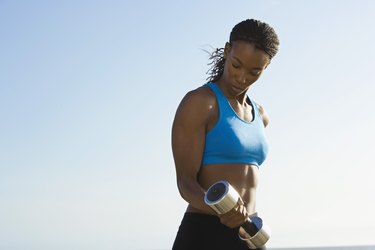
It's not easy to accomplish biceps long head isolation in exercise without tackling the entire biceps. There are a number of long head biceps workouts you can do to grow your upper arm muscles, from variations on the biceps curl, to 10-minute exercises, to the movement researchers consider the "best" biceps workout.
Anatomy of the Biceps
Video of the Day
The biceps brachii is a two-headed muscle, located in front of the upper arm bone, or the humerus, though it is not attached to the bone itself. According to Teach Me Anatomy, the long head and short head originate from different areas of the shoulder joint and insert into the elbow joint.
Video of the Day
The biceps muscles allow the arm to turn, from palm up to palm down. They also allow the arm to flex at the elbow and the shoulder. Although a complete rupture of a tendon in the body is rare, the long head of the biceps brachii is one of the most likely tendons to rupture.
Best Long Head Biceps Workout
In an August 2014 study commissioned by the American Council on Exercise (ACE) and carried out by the University of Wisconsin, LaCrosse, a team of exercise scientists found that there is, in fact, a "best" biceps workout. Researchers compiled a list of the most common biceps exercises, such as cable curls, barbell curls, concentration curls, chin-ups and more.
The researchers then got 16 volunteers between the ages of 18 and 24 to perform the different exercises and measured muscle activity with a wireless electromyography machine. They found "the concentration curl" to be the most effective. The reason? Unlike the other exercises, it completely isolates the biceps.
There may also be a psychological component to why the concentration curl is more effective. Looking down and seeing your muscles working may help garner motivation and focus.
Read more: Workouts for Different Parts of the Biceps
10-Minute Biceps Workouts
Gaining biceps muscle doesn't have to mean spending hours at the gym every week. ACE recommends 10-minute biceps workouts that are equally effective and efficient:
- Alternating biceps curl: Hold a dumbbell in each hand, palms facing toward the hips. Curl each dumbbell up, one at a time, and rotate the palm to face the shoulder. Make sure to keep the legs slightly bent and elbows close to the sides of the torso. Do 10 to 15 repetitions.
- Plank hammer: Situate yourself in plank position and place each hand on top of a dumbbell. Lift each arm up one at a time. Keep the body aligned, abdominals engaged, hips steady and elbows directly underneath the shoulders. Do 10 to 15 repetitions.
- Reverse curl: With a dumbbell in each hand, palms facing away from the body, curl the dumbbells up close to the body, then slowly lower the weights. Make sure the knees are bent and the abs are engaged. Do 10 to 15 repetitions.
Read more: How to Get Defined Biceps
Variations of the Biceps Curl
There are far more ways than one to perform a biceps curl. Though no matter the method, the result will almost always be the same: muscular biceps. ACE describes several variations of the biceps curl, including:
- Biceps curl with isometric squat: Lower down into a squat and place the arms in front of the legs, palms facing up, dumbbells in hand. Continue to hold the squat position while curling the dumbbells and keeping the elbows stuck to the thighs.
- Drag curl to front press: Stand holding a dumbbell in each hand, palms facing up. Pull the elbows back and lift the dumbbells to chest height. After this pulling motion, press the arms forward so that they are parallel to the ground. Then pull the dumbbells back in and lower them. Repeat this motion.
- Upper cuts with bob and weave: Begin in a squat position holding the dumbbells at shoulder height. Perform four upper cuts, punching toward the ceiling on the right side. Bob to the left side and do another four upper cuts.